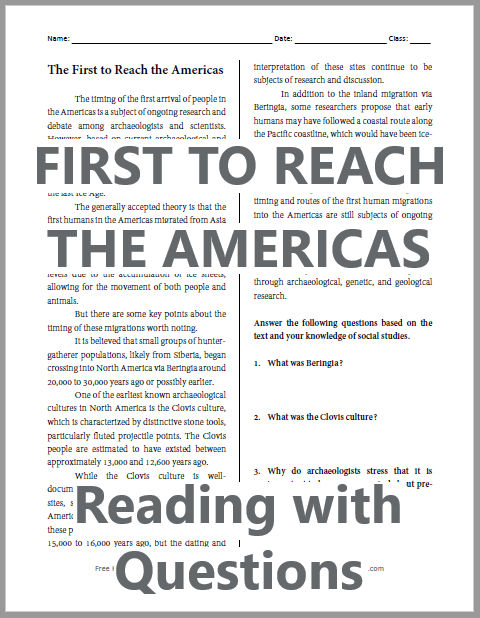First to Reach the Americas Reading with Questions |
| www.studenthandouts.com > U.S. History > Early America > Early America Worksheets |
 |  |
|---|
Click here to print. Answer key: (1) land bridge that connected Siberia and Alaska; (2) culture that existed as far back as 13,000 years ago in North America; (3) answers will vary, but should center on the point that there is always new, and possibly contradictory, evidence to be discovered.
|
The timing of the first arrival of people in the Americas is a subject of ongoing research and debate among archaeologists and scientists. However, based on current archaeological and genetic evidence, it is generally believed that the first human migrations into the Americas occurred during the late Pleistocene epoch, or the last Ice Age.
The generally accepted theory is that the first humans in the Americas migrated from Asia across a land bridge that once existed between Siberia and Alaska, known as Beringia. This land bridge emerged during periods of lower sea levels due to the accumulation of ice sheets, allowing for the movement of both people and animals. But there are some key points about the timing of these migrations worth noting. It is believed that small groups of hunter-gatherer populations, likely from Siberia, began crossing into North America via Beringia around 20,000 to 30,000 years ago or possibly earlier. One of the earliest known archaeological cultures in North America is the Clovis culture, which is characterized by distinctive stone tools, particularly fluted projectile points. The Clovis people are estimated to have existed between approximately 13,000 and 12,600 years ago. While the Clovis culture is well-documented, there is also evidence of pre-Clovis sites, suggesting that human presence in the Americas may date back even further. Some of these pre-Clovis sites have been dated to around 15,000 to 16,000 years ago, but the dating and interpretation of these sites continue to be subjects of research and discussion. In addition to the inland migration via Beringia, some researchers propose that early humans may have followed a coastal route along the Pacific coastline, which would have been ice-free during certain periods. This theory suggests that coastal migration could have occurred as early as 20,000 years ago. It is important to note that the precise timing and routes of the first human migrations into the Americas are still subjects of ongoing investigation, and new discoveries and evidence may refine our understanding of this history. The peopling of the Americas is a complex and fascinating topic that continues to be explored through archaeological, genetic, and geological research. Answer the following questions based on the text and your knowledge of social studies. 1. What was Beringia? 2. What was the Clovis culture? 3. Why do archaeologists stress that it is important to keep an open mind about pre-historical dates? |
| Early America Books and Films | Early America Image Galleries |
| Early America Learning and Study Games | Early America Miscellany |
| Early America Outlines and PowerPoints | Early America Worksheets |
| www.studenthandouts.com > U.S. History > Early America > Early America Worksheets |









